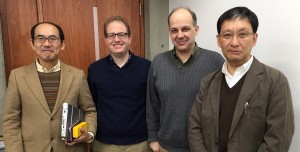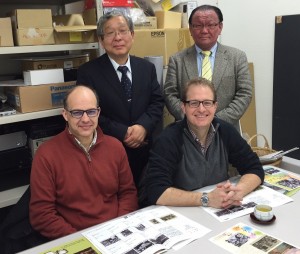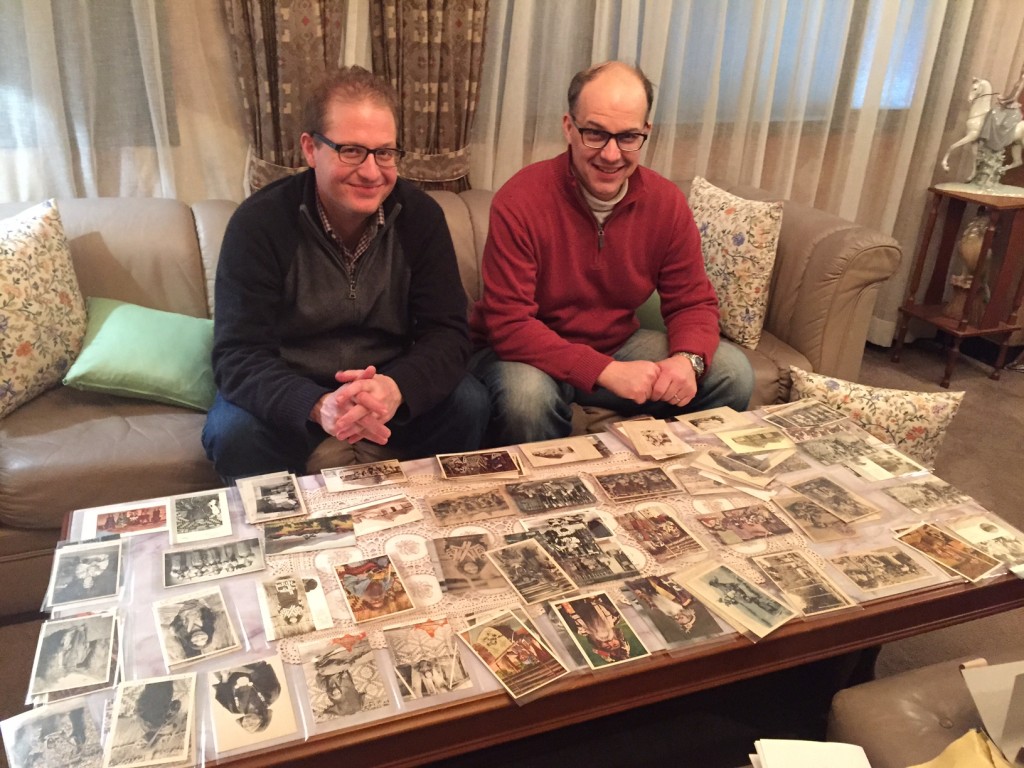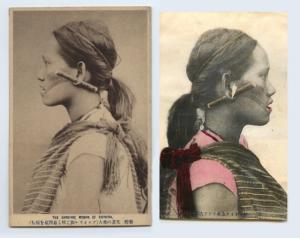Since its launch in 2007, the East Asia Image Collection (EAIC) has garnered international attention with its open access collection of over 5000 postcards, photographs and ephemera tracing the visual history of the Japanese Empire. The collection is curated by Lafayette history professor Paul Barclay and Director of Skillman Library’s Digital Scholarship Services, Eric Luhrs. The success of the collection has brought attention to the fact that though these physical materials are plentiful, particularly in Japan, access to them has been difficult for researchers.
This month Barclay and Luhrs met with a team at Kyoto University with the aim of connecting their complementary collection of materials to Lafayette’s as a model for creating cross-institutional archival collections. Connecting databases and archives across national borders will allow users to search multiple collections at once and gain access to a much wider set of materials.

Kishi Toshihiko, Eric Luhrs, Paul Barclay and Shoichiro Hara at Kyoto University’s Center for Integrated Area Studies
Luhrs joined Barclay at Kyoto University, where Barclay has been working as a visiting researcher this year, to discuss the logistics of a new collection at the Center for Integrated Area Studies and to work with their team to discuss the architecture necessary to link the two collections. The result of the meeting was a truly collaborative project. “We decided to build a pilot database with 139 of our records and about an equal number of theirs,” explains Barclay. “Having both teams in the same room enabled us to hammer out some of the key components of this project including translation, cataloging methods, and modes of development.” With the combination of these resources, the project is now moving forward and Barclay and Luhrs will present their initial findings in August to an international audience at a Digital Scholarship workshop held at Harvard University.
Expanding the reach of the EAIC even further, Barclay and Luhrs also met with Directors Matsuo and Watanabe of the Showa Memorial Museum in Tokyo. Matsuo visited Lafayette earlier this year and expressed interest in a set of Kodachrome slides from the Gerald & Rella Warner Japan Slide Collection and in the diaries and photos of Lafayette alum Robert Trout (’34) who was a medical supplies officer in Japan from 1945-46. Both of these collections are currently held in Lafayette’s Special Collections and digital versions of these items will now be included in a permanent exhibit as well as in the Showa’s spring exhibit, which draws an average of 12,000 visitors every April.

Paul Barclay and Eric Luhrs with Matsuo Kiminari and Watanabe Kazuhiro, of the Showa Memorial Museum
The Showa team will, in turn, lend their expertise with the transcription of a set of handwritten letters sent from the families of Japanese soldiers interred in American prison camps in the Philippines after World War II. This material was donated by Lafayette alum Brett Doyle (’10) and his family and is currently housed in Lafayette’s Special Collections.
As a whole, this trip has been an incredibly rich opportunity not only to boost Lafayette’s profile in Asia and increase the research audience for the EAIC, but also to build lasting modes of international cooperation that will continue to foster innovative research.
For more information about this project or on starting a new digital project with DSS contact us at digital@lafayette.edu, or call (610) 330-5796.


